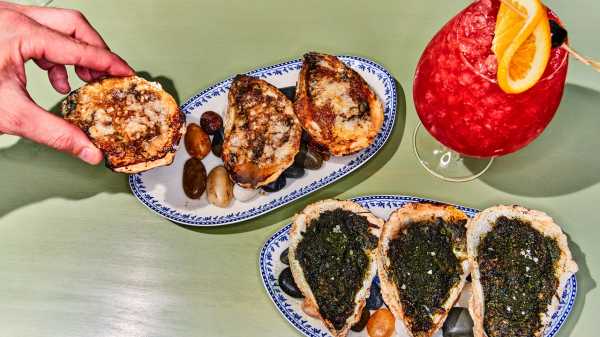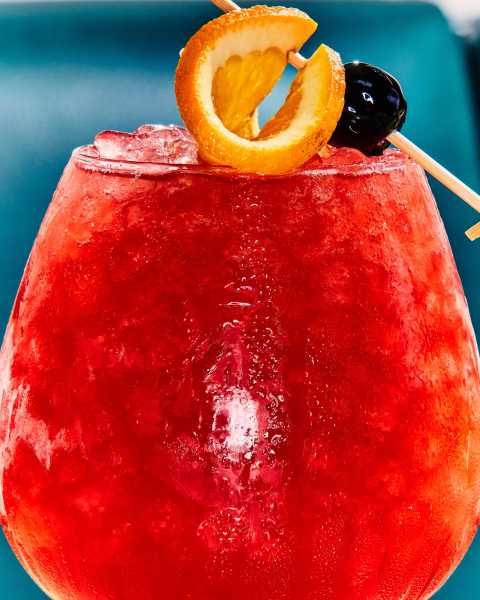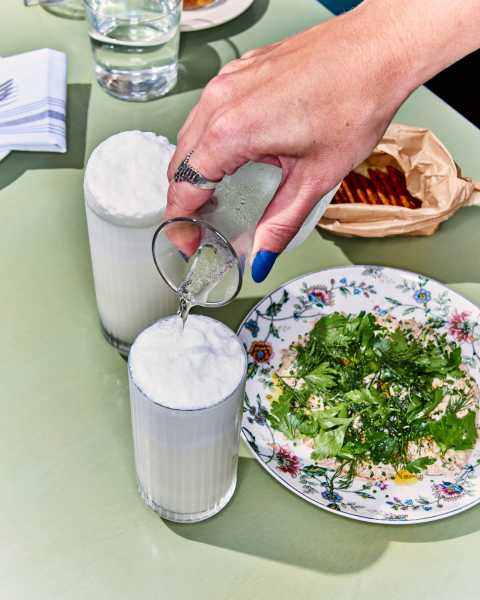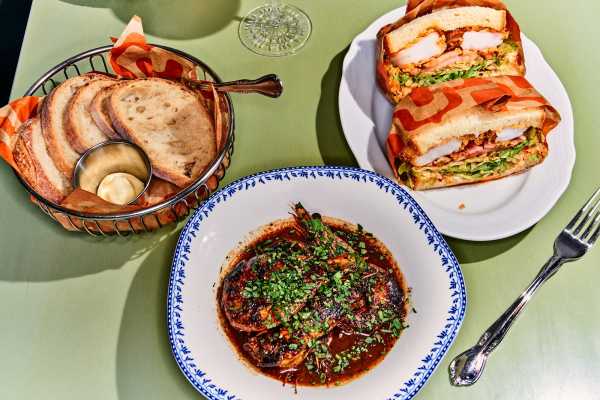
Save this storySave this storySave this storySave this storyYou’re reading the Food Scene newsletter, Helen Rosner’s guide to what, where, and how to eat. Sign up to receive it in your in-box.
It’s rare to find a Ramos Gin Fizz in this town, perhaps because of the labor involved in making one. The ingredients in the beverage, a hundred-and-forty-year-old New Orleans specialty, aren’t too exotic: fresh lemon juice, simple syrup, a splash of orange-blossom water, a drop of cream for richness, and whipped egg white for body. But to get the drink’s signature baby-smooth texture, its lighter-than-air foamy lift, the little white cap that rises above the rim of the highball glass like a sweet and boozy soufflé, you’ve got to shake the mixture with the intensity and focus of a politician glad-handing at a New Hampshire diner. Twelve to fifteen minutes of shaking, they say, which is more time than most bartender staffing schedules (not to mention most human triceps) will allow. You can find a classic version at Valerie, the midtown gin lounge. Shinji’s, a mad-scientist cocktail parlor in Flatiron, uses “moon rocks”—tiny pebbles of nitrous-frozen heavy cream which do something molecular that condenses the whole process to just five seconds. No matter the approach, it’s not a drink undertaken lightly.

The Grand Aioli, a veggie platter, gets a Creole spin with a bowl of sauce rémoulade and (not pictured) a heaping portion of chilled shrimp and crab.
At Strange Delight, a scintillating new Crescent City-inspired seafood restaurant in Fort Greene, the first Ramos Gin Fizz I ordered took something like three weeks. Despite its place of honor on the cocktail side of the menu, when I first asked for the drink I was told that, alas, the team hadn’t yet nailed its version, a portion for two that runs a somewhat reasonable forty dollars. There’s no hurrying perfection: what finally arrived, on a subsequent visit, was a dream in a glass, with the zip of citrus and the velvet of cream, and the fizz in the Fizz kept fizzy by a little sidecar of club soda intended to be poured in bit by bit. When I asked Anoop Pillarisetti, one of the restaurant’s owners, what took so long to get right, he told me that the missing ingredient was actually a tool: an iSi carbonation cannister, suggested by Ham El-Waylly, the restaurant’s co-owner and chef, which helped streamline drink-making time.
Strange Delight is friendly, and low-key in a meticulous sort of way; it’s the kind of restaurant where it feels perfectly natural to find a legendarily difficult cocktail, rigorously simplified. New Orleans-inspired restaurants have too often veered toward cultural caricature—think gaudy interiors draped in Mardi Gras beads and artificial Spanish moss, presumably to distract from slop-like gumbo and étouffée. Strange Delight is the latest in a small crew of excellent Cajun and Creole joints that have opened in the city in recent years, among them tiny Lowerline, in Prospect Heights; Filé Gumbo Bar, in Tribeca; and the clever Korean-Cajun hybrid Kjun, in Murray Hill. But none has evoked the city of inspiration quite so subtly and studiously. Strange Delight visually quotes certain details of storied New Orleans restaurants: the tiled walls of a long counter in a front room call to mind Casamento’s, the famous oyster bar. The tiled floors are reminiscent of the classic French Quarter eatery Arnaud’s. The higher-than-head-height coat hooks are straight out of Galatoire’s, and the green-and-white color scheme summons the iconic window shutters at Treme’s legendary Creole restaurant Dooky Chase. The inspiration is on the menu, as well, in charbroiled oysters “inspired by Felix’s,” or fried-shrimp and fried-oyster sandwiches–a.k.a. “loaves,”—that are “a loving homage to Casamento’s.” I found this food-nerdy reverence irresistibly charming.

The Having Fun Since 1933 cocktail.

The Ramos Gin Fizz for two streamlines a notoriously labor-intensive cocktail.
El-Waylly mans the pass in Strange Delight’s slip of a kitchen. A chef and recipe developer, he has lately become a serious culinary social-media star alongside his wife, Sohla (who is not connected to the restaurant), and his charisma turns out to be considerable in real life, too. (The first time I met him, he was wearing Birkenstock clogs in a striking Yves Klein blue; I immediately bought an identical pair.) Pillarisetti, a veteran of Momofuku and Shake Shack, can often be spotted keeping an eye on the dining room; the two are partners with Michael Tuiach, of the vegan fast-food mini-chain Moonburger. Smartly, the menu’s culinary homages are more riffs than facsimiles. Galatoire’s oysters Rockefeller, broiled with the expected spinach and dash of Herbsaint, are deepened with a hint of dill and a slinky, stinky wisp of anchovy. Casamento’s fried-seafood sandwiches, piled high with pickles and Duke’s mayo and shredded iceberg, are served not on the traditional Texas toast but between slices of chewy-soft and faintly sweet Japanese milk bread. Rich, creamy dips—a cold one made of smoked fish, a hot one made with fresh crab and a hit of Pernod—come with a brown-paper bag of buttery fried Saltines that have an unexpected red-pepper kick.

The BBQ shrimp (center) and a shrimp-loaf sandwich pay homage to renowned New Orleans restaurants.
Strange Delight bills itself as an oyster bar (for a time, the restaurant’s Web site was oysterdisco.com), though just one variety of the bivalve at a time appears on the menu, in two sizes: big ones, for frying and broiling, and small ones, for serving raw, with a brisk mignonette dolled up with lashings of Peychaud’s. There are a handful of vegetarian dishes—hush puppies, bronzed and crumbly, served with a dollop of butter whipped with Steen’s cane syrup; a crunchy slaw of Chinese broccoli in a creamy vegan dressing that’s reminiscent of Superiority Burger, in the best way; “mushroom à la escargot,” a gorgeous puddle of garlic butter with plump cremini mushrooms. But the menu is, overwhelmingly, dedicated to the fruits of the sea. In fact, as far as I can tell, no nonaquatic creatures make appearances at all. There’s still plenty to choose from, and it’s hard to go wrong, though if you need to narrow things down I’d say you can skip the marinated crab claws, which are visually striking but fairly bland, and the striped bass amandine, which can’t compete with a revelatory blackened swordfish belly that’s so buttery and rich it’s nearly liquid. In the course of several visits, I found myself returning to a few standouts: the Felix’s-inspired oysters, broiled under a comforting, black-peppery blanket of parmesan and garlic, and a BBQ shrimp “derivative of Pascal’s Manale,” the New Orleans restaurant said to have invented the dish. At Strange Delight, it features four enormous crustaceans peering out of a dark and velvety concoction made from beer, butter, and spices. The shrimp were delicious, head and all, but the sauce was so magnificent—complex, savory, sweet, sultry—that I was tempted to lift the bowl and slurp it down like soup.
Helen, Help Me!
E-mail your questions about dining, eating, and anything food-related, and Helen may respond in a future newsletter.
A meal at Strange Delight can feel refined or rowdy, depending on where you sit. The front room, with counter seats outlining the oyster bar and high-top tables along the walls, has a mood of communal vivacity—the ring of cross-table conversation, the banter of hustling cooks and shuckers, the non-stop movement of servers wiggling through the narrow spaces between tables. All of it is amplified by the shiny, acoustic-enhancing tiled walls, but it’s a cacophony that feels energizing rather than overwhelming. Through a narrow passage, past a glass-walled wine-storage area containing an impressive selection of natural bottles, lies a high-ceilinged back dining room anchored by an enormous wood-and-marble bar. This room, too, feels like a version of New Orleans—more modern, a little sleeker, less burdened by the weight of history and tradition. In this room, lingering over Le Grande Remoulade (a heaping portion of chilled shrimp and crab, sweet and briny, tossed in a creamy sauce tinged pink with spices, alongside an array of crudités and a satin-yolked boiled egg) feels leisurely rather than boisterous. Toward the end of dinner in the back room one evening, having giddily over-ordered and reached a physical inability to carry on eating, I nevertheless found myself taking bite after bite of the little portion of bread pudding that all diners receive as a complimentary dessert, prolonging the meal, delaying my departure, simply because being there felt so good. ♦
Sourse: newyorker.com